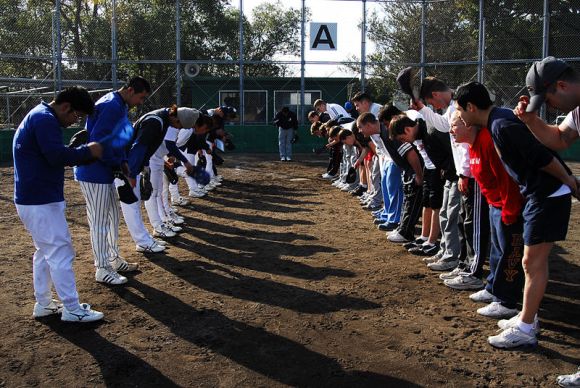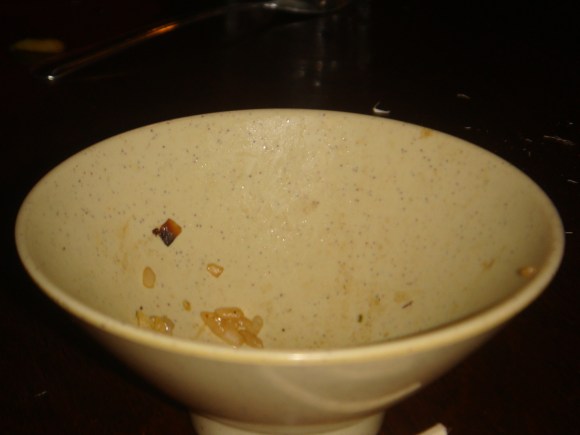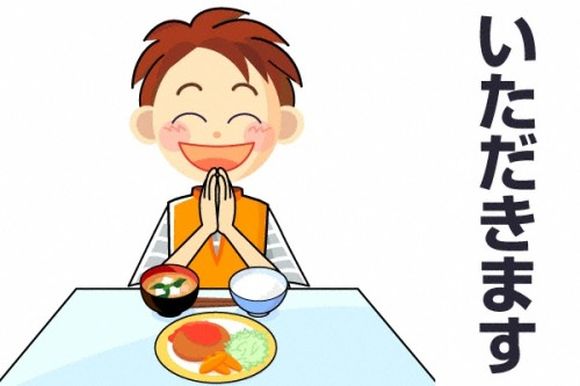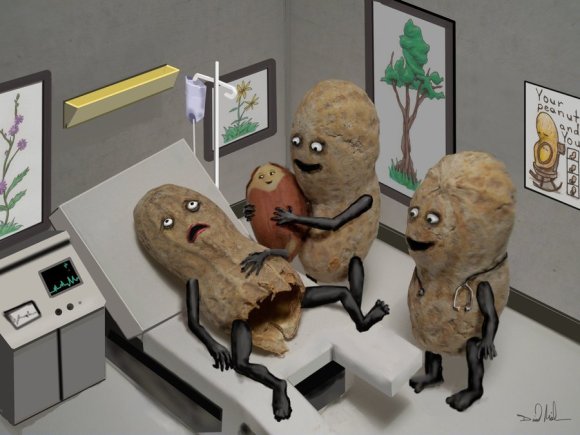
Well, good afternoon/evening/morning/day everyone! Today we’re going to talk about Japanese greetings and what they really mean.
Just as in English, “Konnichiwa” or “Good day” is a greeting that is technically an idiom with a complex and near-forgotten past. Just as English language greetings tend to stem from bastardizations of foreign loan words and/or full sentences that have been gradually shortened over the years, “konnichiwa” is actually a shortened version of a full and meaningful greeting, because, if anything, human beings are a lazy sort with a bad habit of cutting corners whenever possible.
“Konnichiwa,” back in the day, was actually the beginning of a sentence that went, “konnichi wa gokiken ikaga desu ka?,” or “How are you feeling today?” (今日はご機嫌いかがですか?)
Building on that, it’s easy to see that the traditional Japanese greeting in the evening, “Konbanwa“ is basically the same thing, but with “this evening” substituted for “today” (今晩はご機嫌いかがですか?).
When it comes to mornings, we deviate slightly with “ohayou” or “ohayou gozaimasu“ depending on how much you respect the recipient of the greeting (when it comes to my editor, he gets nothing but a curt, “ossu.”), which is spelled in Japanese, “お早う,” or, literally, “It’s early!” Again, humans being the lazy things we are, we can’t be bothered doing anything more than exclaiming about the ungodly hour every morning, so this is understandable.
There’s even more word origin fun to be had with Japanese greetings/idioms:
“Arigatou” or “Thank you” is spelled something like this in Japanese: 有難う, which, taken literally, means, “It’s hard that this exists.” In other words, you’re expressing gratitude for someone doing something difficult or going out of their way for you.
“Gochisousama,” the traditional phrase uttered after a fulfilling meal, and spelled “ご馳走様,” in Japanese literally means, “You ran around!” It sounds weird to an English speaker, of course, but it’s meant to recall a hard-working chef hustling to and fro to prepare a meal.
“Itadakimasu,” the phrase one is supposed to say just before tucking into a meal, on the other hand, is spelled “頂きます,” or literally, “I take!” While it sounds a little blunt and self-serving in English, it’s not hard to understand that this honorific phrase is used to express gratitude to the chef or host.
“Otsukaresama” is a greeting you’ll hear a lot around Japanese offices, schools and any other place where people work hard. The Japanese, “お疲れ様,” literally meaning, “You look tired!” The 様 part, which appears in a lot of these greetings/idioms, is hard to explain in English, but it stems from the Japanese の様 (“no yo,” or, “as if”), which denotes an observation on the part of the speaker.
“Omedetou,” (“Congratulations!”) is a more complicated animal, and even after some research and asking Japanese friends, we still aren’t entirely sure of this word’s origins. But, it appears that it stems from the verb, “mederu” (愛でる), “to treat importantly,” combined with “itashi” (甚し), “very.” In other words, you are acknowledging to someone that their accomplishment is “very important” to you. Note that the current kanji characters used for this, “お目出度い,” are actually what is referred to as “ateji” or kanji characters assigned to fit the sound of the word, rather than the other way around, and have nothing to do with the word’s meaning/origin.
Bonus tip! Being the incredibly handsome/gorgeous bilingual journalists we are, RocketNews24 writers feel for the common Japanese language learner. While Japanese grammar can seem perplexing at first, it’s actually quite intuitive. Take, for example, the verb modifier, “miru,” as in “shite miru,” or, “I will try.” When you look at the origin of this modifier, “して見る,” you see that it literally means, “I will do it, and see.” So, if you were to say something like, “歌ってみる,” at your next office karaoke session, you’re literally saying, “I will sing this song, and see [how it goes].” In our case, it will always go poorly.
If you’re looking for more Japanese language primers, you can check out Rachel, who inspired this article, on YouTube:
Feature photo: Wikimedia Commons, Inset 1, Inset 2, Inset 3




 The Japanese you learn at school vs the Japanese used in Japan【Video】
The Japanese you learn at school vs the Japanese used in Japan【Video】 BuzzFeed’s video of “anime expressions” delivers more laughs than useful language pointers
BuzzFeed’s video of “anime expressions” delivers more laughs than useful language pointers Lingo mambo! Spanish YouTuber teaches us 14 Taiwanese pet phrases【Video】
Lingo mambo! Spanish YouTuber teaches us 14 Taiwanese pet phrases【Video】 Japanese company Yellow Hat hilariously mistakes Pizza Hut for Italian dish-themed headwear
Japanese company Yellow Hat hilariously mistakes Pizza Hut for Italian dish-themed headwear The three ways to say “love” in Japanese, and when to use them
The three ways to say “love” in Japanese, and when to use them Japan’s new difficult-to-drink-from beer glass protects your liver, but it’s a brutal experience
Japan’s new difficult-to-drink-from beer glass protects your liver, but it’s a brutal experience Demon Slayer: Kimetsu no Yaiba gets new roller coaster attractions and food at Universal Studios Japan
Demon Slayer: Kimetsu no Yaiba gets new roller coaster attractions and food at Universal Studios Japan How to order snacks on a Shinkansen bullet train in Japan
How to order snacks on a Shinkansen bullet train in Japan Burger King Japan suddenly adds Dr. Pepper and Dr. Pepper floats to its menu nationwide
Burger King Japan suddenly adds Dr. Pepper and Dr. Pepper floats to its menu nationwide New Pokémon ice cream, dessert drinks, and cool merch coming to Baskin-Robbins Japan【Pics】
New Pokémon ice cream, dessert drinks, and cool merch coming to Baskin-Robbins Japan【Pics】 Caffeinated ramen for gamers that you can eat with one hand going on sale in Japan
Caffeinated ramen for gamers that you can eat with one hand going on sale in Japan New samurai glasses are Japan’s latest weird must-have souvenir
New samurai glasses are Japan’s latest weird must-have souvenir McDonald’s adds new watermelon frappe and fruity macaron to its menu in Japan
McDonald’s adds new watermelon frappe and fruity macaron to its menu in Japan Princesses, fruits, and blacksmiths: Study reveals the 30 most unusual family names in Japan
Princesses, fruits, and blacksmiths: Study reveals the 30 most unusual family names in Japan We check out the local flavors of the commonly confused Ome and Aomi areas of Tokyo in one day
We check out the local flavors of the commonly confused Ome and Aomi areas of Tokyo in one day Nintendo history you can feel – Super NES, N64, and GameCube controllers become capsule toys
Nintendo history you can feel – Super NES, N64, and GameCube controllers become capsule toys Hello, cosmetics! Clinique teams up with Hello Kitty this summer for first-time collaboration
Hello, cosmetics! Clinique teams up with Hello Kitty this summer for first-time collaboration “The most Delicious Cup Noodle in history” – Japan’s French Cup Noodle wins our heart【Taste test】
“The most Delicious Cup Noodle in history” – Japan’s French Cup Noodle wins our heart【Taste test】 Starbucks releases a cute Frappuccino and Unicorn Cake…but not in Japan
Starbucks releases a cute Frappuccino and Unicorn Cake…but not in Japan Kyoto Tower mascot termination reveals dark side behind cute Japanese characters
Kyoto Tower mascot termination reveals dark side behind cute Japanese characters McDonald’s Japan’s Soft Twist Tower: A phantom ice cream only sold at select branches
McDonald’s Japan’s Soft Twist Tower: A phantom ice cream only sold at select branches Yabai Ramen: What makes this Japanese ramen so dangerous?
Yabai Ramen: What makes this Japanese ramen so dangerous? Finally! Nintendo Japan expands Switch 8-bit controller sales to everybody, Online member or not
Finally! Nintendo Japan expands Switch 8-bit controller sales to everybody, Online member or not Japanese government wants to build luxury resorts in all national parks for foreign tourists
Japanese government wants to build luxury resorts in all national parks for foreign tourists To combat declining birth rate, Japan to begin offering “Breeding Visas” to foreigners
To combat declining birth rate, Japan to begin offering “Breeding Visas” to foreigners 10 things you should buy at 7-Eleven in Japan
10 things you should buy at 7-Eleven in Japan Studio Ghibli releases anime heroine cosplay dresses that are super comfy to wear
Studio Ghibli releases anime heroine cosplay dresses that are super comfy to wear Woman charged for driving suitcase without a license in Osaka
Woman charged for driving suitcase without a license in Osaka Studio Ghibli unveils My Neighbour Totoro miniature house model
Studio Ghibli unveils My Neighbour Totoro miniature house model Kyoto experiencing problems with foreign tourists not paying for bus fares, but not on purpose
Kyoto experiencing problems with foreign tourists not paying for bus fares, but not on purpose Fighting mild hunger with a Japanese soda that turns into jelly in the stomach【Taste test】
Fighting mild hunger with a Japanese soda that turns into jelly in the stomach【Taste test】 Studio Ghibli’s Howl’s Moving Castle tapestry unveiled in Japan for first time
Studio Ghibli’s Howl’s Moving Castle tapestry unveiled in Japan for first time McDonald’s new Happy Meals offer up cute and practical Sanrio lifestyle goods
McDonald’s new Happy Meals offer up cute and practical Sanrio lifestyle goods Sales of Japan’s most convenient train ticket/shopping payment cards suspended indefinitely
Sales of Japan’s most convenient train ticket/shopping payment cards suspended indefinitely Sold-out Studio Ghibli desktop humidifiers are back so Totoro can help you through the dry season
Sold-out Studio Ghibli desktop humidifiers are back so Totoro can help you through the dry season Japanese government to make first change to romanization spelling rules since the 1950s
Japanese government to make first change to romanization spelling rules since the 1950s Foreigner’s request for help in Tokyo makes us sad for the state of society
Foreigner’s request for help in Tokyo makes us sad for the state of society Ghibli founders Toshio Suzuki and Hayao Miyazaki contribute to Japanese whisky Totoro label design
Ghibli founders Toshio Suzuki and Hayao Miyazaki contribute to Japanese whisky Totoro label design Doraemon found buried at sea as scene from 1993 anime becomes real life【Photos】
Doraemon found buried at sea as scene from 1993 anime becomes real life【Photos】 Tokyo’s most famous Starbucks is closed
Tokyo’s most famous Starbucks is closed “How do you google using Yahoo?” and other amazing questions from Japan’s Yahoo! Answers
“How do you google using Yahoo?” and other amazing questions from Japan’s Yahoo! Answers Should you say “Itadakimasu,” Japan’s pre-meal expression of thanks, when eating by yourself?
Should you say “Itadakimasu,” Japan’s pre-meal expression of thanks, when eating by yourself? Five magic Japanese phrases to know before starting a job in Japan
Five magic Japanese phrases to know before starting a job in Japan How do you say ‘Google it, you trash’ in British English? Answer surprises many in Japan
How do you say ‘Google it, you trash’ in British English? Answer surprises many in Japan Wait, the Japanese word daijoubu can mean both “yes” and “no?” Why? HOW?!?
Wait, the Japanese word daijoubu can mean both “yes” and “no?” Why? HOW?!? Japanese government says Internet slang is too hard to understand, issues guidelines for netspeak
Japanese government says Internet slang is too hard to understand, issues guidelines for netspeak Monkey Majik and Taiiku Okazaki team up for bilingual Japanese-English track【Video】
Monkey Majik and Taiiku Okazaki team up for bilingual Japanese-English track【Video】 Our Japanese language reporter visits Barcelona, decides to try Spanish “hosho maki” sushi
Our Japanese language reporter visits Barcelona, decides to try Spanish “hosho maki” sushi Japanese woman punches boyfriend, charms Internet following his terrible restaurant manners
Japanese woman punches boyfriend, charms Internet following his terrible restaurant manners Nine reasons why Japanese men hesitate to say “I love you”
Nine reasons why Japanese men hesitate to say “I love you” Tokyo’s sushi spirit shrine, where the souls of seafood slumber
Tokyo’s sushi spirit shrine, where the souls of seafood slumber Dark Horizon textbooks go beyond “Hello my name is…” to “Who are you calling a bitch, bitch!”
Dark Horizon textbooks go beyond “Hello my name is…” to “Who are you calling a bitch, bitch!” 85-year-old great-grandmother from Hiroshima is Japan’s newest virtual YouTuber/idol【Video】
85-year-old great-grandmother from Hiroshima is Japan’s newest virtual YouTuber/idol【Video】 90-year-old Japanese granny is learning English from her grandchild, and it’s extremely precious
90-year-old Japanese granny is learning English from her grandchild, and it’s extremely precious “Good on the floor?” Five funny times Google Translate drops the ball with Japanese idioms
“Good on the floor?” Five funny times Google Translate drops the ball with Japanese idioms
Leave a Reply